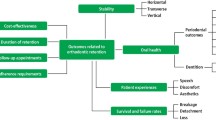Abstract
Objective
To assess the effect of the introduction of orthodontic therapists (OTs) on the quality of orthodontic treatment outcomes in two specialist orthodontic practices in the UK.
Study design
Retrospective cross sectional observational study.
Setting
Multi-centre evaluation at two specialist orthodontic practices in Yorkshire. Data collection was carried out during 2014.
Materials and methods
The treatment undertaken by three specialist orthodontic clinicians (A, B and C) was evaluated at two time points. The first time point (T1) was before the introduction of OTs when the specialist orthodontic clinicians were solo operators. The second time point (T2) followed the introduction of OTs. Patients at T2 had their treatment planned by a specialist orthodontist and were seen for care by both the orthodontist and an OT who had been qualified for a minimum of three years. A sample size of 30 orthodontic patients per clinician at each time point was chosen. Included participants had completed a course of fixed appliance therapy. They were consecutively selected from cases that had been completed in the specified time frame for each clinician.
Main outcome measures
The quality of treatment was assessed objectively using the quantitative Peer Assessment Rating index (PAR index). Data extracted from the specialist practice databases also allowed conclusions to be drawn about the length of treatment time and number of appointments in each treatment group.
Results and conclusions
There appears to have been no change in orthodontic treatment outcomes following the introduction of supervised OTs at two specialist orthodontic practices.
Similar content being viewed by others
What difference do orthodontic therapists make to outcomes?

Orthodontic therapists – has their introduction affected Orthodontic Peer Assessment Rating (PAR) outcomes? Br Dent J 2016; 221: 421–424.
In any walk of life, debate about the value of auxiliary or assistant team members surrounds their potential usefulness, their acceptability by fellow team members and the customers or clients they serve, and the cost-effectiveness of their activities. Translating this into the dental surroundings is no different and the major clue to the process are the letters DCP (dental care professionals). A major change in orthodontics over the last decade has been an increase in the workforce with the introduction of orthodontic therapists (OTs) trained at eight centres in the UK. This has led to improved access to specialist-led orthodontic care and to altering the skill mix of the orthodontic team. Utilisation of OTs has also lowered the cost of supply of orthodontic treatment. The aim of this study was to assess the effect that the introduction of the OTs has had on the quality of orthodontic treatment outcomes as assessed by an index (the PAR index) which enables objective measurement of orthodontic treatment outcome by analysing pre- and post-treatment study models, and the duration of treatment. A retrospective, cross-sectional observational study was undertaken at two specialist orthodontic practices in Yorkshire where treatment was undertaken by specialist orthodontic clinicians and evaluated at two time points on 168 participants. There was no change in orthodontic treatment outcomes following the introduction of OTs as measured by length of treatment time, number of appointments or PAR index change. The study highlights excellent standards of treatment and although the results are not universally applicable they suggest the possible value of this group of DCPs in orthodontic practice. Such studies are of great value in the ongoing assessment of DCP roles not only from the viewpoint of dental practices but also from those who fund oral care, be they governments, insurance companies or indeed patients themselves. In straitened economic times such considerations are all the more important.
By Stephen Hancocks OBE, BDJ Editor-in-Chief
Expert view

Dirk Bister
Programme Director, Orthodontic Therapy, King's Health Partners, London
Consultant Orthodontists, Guy's and St Thomas' NHS Foundation Trust
Honorary Reader King's College London
This cross-sectional retrospective study looks at orthodontic treatment outcomes before and after therapists were introduced to two specialist practices in the North of England. In order to register as an orthodontic therapist (OT), dental nurses need to undertake a one year course approved by the GDC and pass a summative examination by the Royal College of Surgeons of Edinburgh or England. The salaries of therapists are generally below that of dental specialists. The Orthodontic Peer Assessment Rating Score (PAR) was used as an outcome measure. This score measures ‘hard data’ ie reduction of overjet, overbite, centreline correction etc. The PAR score reductions were similar before and after the introduction of therapists, which leads the authors to conclude that introducing skill-mix results in comparable treatment outcomes. Length of treatment and number of appointments were also unaffected. The GDC's Scope of practice1 defines the areas of training, skills and knowledge for OTs to practise safely. However, this publication is not completely consistent with the guidelines issued by the British Orthodontic Society and the Orthodontic National Group.2 The latter document distinguishes between tasks where supervision is recommended and tasks where it is required, thereby questioning if patients need to be seen by a supervising dentist at every single visit, or indeed if the dentist has to be on site when therapists provide treatment.3 The authors of this paper stress that the specialists supervised the therapists at every visit and it is therefore not surprising that the measured outcomes were identical. One would expect the PAR score to reflect the expertise of the individuals who made and continuously revised the treatment plan which in this case were the supervisors. Additionally the PAR score, however objective, is only one of a number of performance indicators (also known as ‘vital signs’) that help Primary Care Organisations to monitor orthodontic activity and quality of patient care. It would have been interesting to find out if the introduction of therapists made a difference to other metrics, particularly patient reported outcome and experience measures.4 Lastly, the authors quote a paper, published by the same team, which suggests a reduction of practice expenditure when skill mix is used. One wonders, assuming that this statement is correct, why this has not yet led to a reduction of costs to the NHS.
Author Q&A

with Claire Rooney University of Leeds
What was the aim of your research?
The aim of the research was to assess whether the introduction of qualified orthodontic therapists into specialist practice had had an effect on treatment outcome. I wanted to compare and contrast the following treatment outcomes at two time points, pre and post-orthodontic therapist employment:
-
1
PAR score change
-
2
Length of time taken to complete treatment
-
3
Number of appointments required.
What was the most challenging part of this study?
As the study was retrospective and cross-sectional, I found that data collection was the most challenging part. Hundreds of study models were required for the study and retrieval was not always straightforward. A number of models were damaged so required repairs prior to being PAR scored which also led to delays in data collection.
Will this study affect changes to skill-mix in the UK?
The changes to the skills mix has already taken place, so this study - the first investigating the impact the orthodontic therapist has had on treatment outcome - whilst unlikely to have an immediate effect on service provision, does provide evidence for the benefit of task delegation within the dental team. This study, however, which showed excellent treatment outcomes for all concerned, may not be generalisable as the orthodontic therapists investigated worked under direct supervision 100% of the time and this may not be achievable when the responsible orthodontist does not achieve the same level of involvement in patient care as here. Further multi-site, prospective studies would help highlight the benefits of increasing the skills mix in the orthodontic team.
References
GDC. Scope of practice. Available online at http://www.gdc-uk.org/Dentalprofessionals/Standards/Documents/Scope%20of%20Practice%20September%202013%20(3).pdf (accessed 22 September 2016).
BOS. Guidelines on supervision of qualified orthodontic therapists. Available online at http://www.bos.org.uk/portals/0/Public/docs/General%20Guidance/Guidelinesonsupervisionoforthodontictherapists2012.pdf (accessed 22 September 2016).
Day C, Hodge T. Supervision of orthodontic therapists: what is all of the confusion about? Faculty Dent J 2011; 2: 192–195.
NHS Dental Services. Orthodontic vital signs report guidance. Available online at http://www.nhsbsa.nhs.uk/Documents/DentalServices/Orthodontic_Vital_Signs_Report_Guidance.pdf (accessed 22 September 2016).
Author information
Authors and Affiliations
Rights and permissions
About this article
Cite this article
Rooney, C., Dhaliwal, H. & Hodge, T. Research insights: Orthodontic therapists – has their introduction affected outcomes?. BDJ Team 3, 16168 (2016). https://doi.org/10.1038/bdjteam.2016.168
Published:
DOI: https://doi.org/10.1038/bdjteam.2016.168



